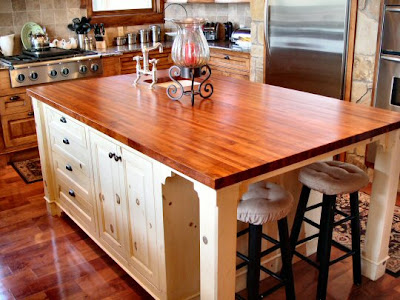
Wood can be arranged in different ways to enhance your new countertops. Not all wood has to be placed in the long planks typically seen in flooring. There are actually three main options you can choose between in regards to placement or orientation. Wood grain, depending on orientation, can affect factors such as durability, appearance, and even functionality.
If you have been looking around for wooden countertops, you may have noticed some terms that you were not familiar with, such as face grain, edge grain and end grain. These are the three main surface orientations used in creating a wood plane.
Face Grain or Plank Grain
For this option, the wide surface of the wood is placed facing upward, and the planks are placed side-by-side as they are glued down to the surface. This surface can appear smooth or indented where the planks are joined, depending on preference. For countertops, the finish should be non-porous in order for it to be sanitary and safe for food preparation.
This type of orientation is considered to be the most decorative, revealing the most grain on a flat surface. To accentuate the beauty of the grains, this countertop provides a sophisticated look by leaving a long, smooth grained surface. However, it is also the softer option of the three and is less resistant to dents and scratches unless a good sealant is applied.
Edge Grain
Edge grain is created by placing planks on their sides. The long, thin edge of the planks faces upwards, and these edges come together to make the work surface. Because this orientation is denser, it is generally more durable than face grain, making it a great work surface if you are looking for functionality in your countertop.
End Grain
For end grain countertops, the ends of the boards face upwards. The surface is formed from the wooden blocks placed next to each other. This is commonly called a "butcher's block," and it is how strong countertops and cutting boards were traditionally made. These surfaces provide a strong work surface and won't damage kitchen knifes, as the wood fibers actually separate when you cut through them. For a serious chef, end grain is an ideal choice.
Whether you are interested in wood purely for its aesthetic value or for its potential durability, the grain orientation can make a big difference. However, no matter which grain orientation you choose, wood is a traditional surface that will be a beautiful addition to your home.
Dara Summers is the VP of Sales and Marketing at Premier Surfaces, the premier source for Atlanta countertops and countertops in Alabama. Premier Surfaces is dedicated to providing the highest level of quality in both products and service. Visit Premier Surfaces at either of their Atlanta, Birmingham, or Huntsville granite showrooms.
No comments:
Post a Comment